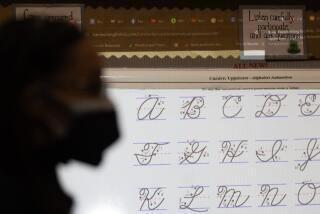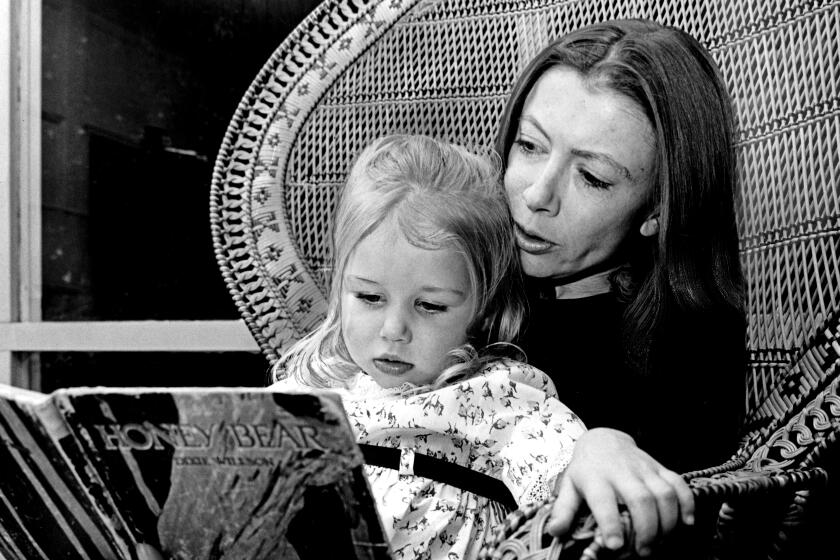Competing With Kindergartners Proves Difficult Task
- Share via
Evidently my column on kindergartners’ definitions of words has goaded some readers into thinking about words and definitions themselves.
Most provocative was the kindergartners’ definition of marriage: “You like that person and you fall in love and you get married.”
As I pointed out, marriage is not easy to define without using the word marriage itself, and that isn’t kosher, as I’m sure Samuel Johnson and Merriam-Webster would agree.
Jean Meltzer, a kindergarten teacher at Castle Heights School, offers a definition invented by someone named Sarah (a pupil of hers, I assume): “It’s when a girl wears a white veil over her head and kisses her boyfriend in front of everybody.”
OK. When that happens, you’re married.
Juanita Matassa of Santa Ana suggested a more complex definition: “The voluntary assumption by two individuals of a lifelong commitment to, and responsibility toward, each other in a bisexual relationship which had its origins in the need of human young for many years of care and training.”
OK. But taking the psychobabble out of that, I would say, marriage is an agreement between a man and a woman to live together and raise children.
The more you think about it, though, the more it goes back to that veil and that kiss.
Henry Brunell of Chatsworth agrees with me that my dictionary’s definition of marriage was “not very good.” I quoted Webster’s New World as saying, “The state of being married; relation between husband and wife; married life.”
“Not very good indeed,” he says. “My dictionary says: ‘The social institution under which a man and a woman establish their decision to live as husband and wife by legal commitments, religious ceremonies, etc.’ ”
That definition, Brunell notes, is in the Random House College Dictionary, 1984.
In this fast-changing world, of course, a definition of marriage that may have applied in 1984 may be out of date in 1991.
Edith Waterhouse of Pacific Palisades felt obliged to expand on the kindergartners’ definitions of brain : “You keep your words that you want to say in there; in your head there’s this thing that makes you think.”
Waterhouse defines the brain as a place: “You keep pictures of times past in there; pictures of people you have loved; all the way from when you first could remember. You keep pictures of the now people you love--and the thoughts of the wonderful things you wish for them in their lives.”
Of course, no one can define the brain. All we know is that our brain is superior to that of the other animals. This superiority makes it possible for us to make war upon one another.
I have a letter from Karen Kinnaman and Jeffery Ward expressing puzzlement over the kindergartners’ definition of vacuum in terms only of a vacuum cleaner, and my definition of it (from Webster) that it is “a space with nothing at all in it.”
They argue that once a vacuum cleaner is turned on it is no longer a vacuum, because it is no longer empty. It seems to me that their argument is like a vacuum cleaner. Once you turn it on it is no longer a vacuum, even though it is still empty.
Clint Rowley of Crestline suggests that children’s answers to some of our great unanswered questions might be as illuminating as their definitions of words.
For example, he suggests asking a child “why there is noise in the forest when a tree falls, even though no one is there to see or hear the tree fall.”
I suggest that the question is not properly put. In saying “why there is noise” one implies the answer. There is noise. The question should be, “Is there any noise . . . ?”
To any thinking child, the answer must be that there is no noise if there is no ear to hear it.
Rowley also suggests asking a child how to tie a tie. I hope it will not be thought sexist of me to point out that there is no reason for half of all children to know how to tie a tie. When the psychologists consider the different problems faced by boys and girls they never mention that boys have to learn how to tie ties.
Many years ago a drunk in a bar taught me how to tie a Windsor knot. I have followed his instructions ever since. However, I can not tie a bow tie. I have a bow tie to wear with my tuxedo. I have a leaflet of instructions for tying it. I have never been able to tie it. I wear a pre-tied tie.
Rowley also suggests that we ask children how to tie shoelaces. That is unfair to children. No one, however old he may be, can tell you how to tie a shoelace.
Try it.
You might as well try to teach a chimpanzee to play Hamlet.
More to Read
Sign up for our Book Club newsletter
Get the latest news, events and more from the Los Angeles Times Book Club, and help us get L.A. reading and talking.
You may occasionally receive promotional content from the Los Angeles Times.









